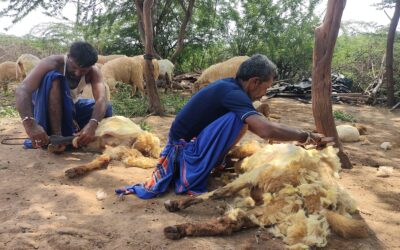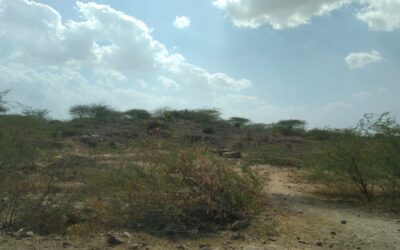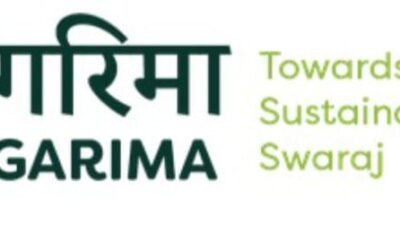In India, 70% of the population is dependent on biodiversity for livelihood. Resources like food, fodder and fertilizer are basic necessities of life. But, working in Bhoola village for the last 10 months has given me an altogether different overview.
It was just another usual day when I was traveling to school in a jeep. On the way, I saw a few children covered in ash, wearing garlands, and blocking the road. At first, I thought people have started with the Holi rituals. Out of my curiosity, I asked the Driver, “What’s happening?”, to which he replied, “Madam, Duski ho, Duski!” Before I could ask further, we had reached school.

Duski? I had never heard of it. So, I approached my school staff with questions. One of the teachers promised to take me along for a real sense of the ritual. Full of excitement, I sat on the bike and went with him to the same place where I had spotted those children. Honestly, I was a bit scared and apprehensive of them throwing ash on me as well. I could see them from a distance, dancing and playing. The moment the teacher parked his bike near a tree, all kids were staring at us. They could figure out that I am an outsider. It felt like even they were eager to meet me.
Before initiating any conversation, I stood for a while trying to observe what’s exactly going on. There, I saw children of all age groups, from toddlers to teenagers, standing in a group, throwing ash on each other. They were enthusiastically waiting for any vehicle to pass by, to stop them and ask for money, which could range from a coin of 1 or 2 Rupees to a 50 Rupee note. If one denies giving money, they’d scare them by showing ash they could throw on them.
I walked closer to the group and saw a boy holding a bird in his hand. At first I thought it to be his dinner for today, but to my surprise, it was just a part of Duski celebrations. I was amazed to see the way he had tied up the bird to his hand so that it doesn’t fly away.

DEVISHRI!
Here in Bhoola village, people call the bird Devishri as DUSKI. On the day of the ritual, since 6 am people get in groups of 15 to 20, and leave their houses to catch this bird. They climb mountains, trees, and run in the fields. After that, they roam around in the whole village to collect money, from which they buy wheat, jaggery, milk and ghee to make a sweet called “Choorma”. It is held around December, decided by the position of the moon.
Along with the Patel (person from higher caste) of the village, people take Devishri to a water resource. The bird is then offered Choorma, and held in hands, ready to set free. Now this is the critical moment for the whole village because after setting free, the place where the bird chooses to sit, decides the fate of the whole village in terms of crops in the coming year. As per the belief, if Devishri sits on a tree, then it will be ‘Sukaal’ i.e. good amount of rain for crops, while if Devishri sits on a rock or stone or a dry bush, then the coming year would bring ‘Akaal’ (famine).
This time, Devishri sat on a tree and people of Bhoola village are in hope of a good year for their crops. Choorma is now distributed among everyone in the village. They dance together to celebrate the good news.

Research shows that even though meteorologists use high-tech gadgets to predict monsoon, for centuries, traditional ways of prediction have also yielded results.
Panchang, the traditional Hindu almanac, found in most Indian Households, is used since 4th century BC in India. It is known to forecast the rainy season accurately and based on that, advice farmers for related agricultural activities at the beginning of the year. In Australia, the Aborigines’ understanding of weather patterns, including observations of animal behavior and flowering of plants, is being harnessed by the Australian Bureau of Meteorology’s Indigenous Weather Knowledge project.
Ethnic tribes and local people like farmers, hunters and fishers are quick in drawing particular pictures about rain and drought, indicating whether it will be favorable or not, for production in the coming year. This local forecasting is derived from empirical observations as well as by noticing sudden changes in behavior and appearance of various insects, animals and birds.
Butterflies, ants, termites and snakes can be seen moving around just ahead of rainfall. Sparrow bathing in dust or swarms of bees in hives, none emerging out, could mean rains in a couple of days. Crows calling at night and owls hooting during the daytime may mean drought. A goat flapping ears restlessly, sheep huddling, owl hooting or frog coming out to croak – all indicate imminent rain.
Such traditional wisdom is available in all parts of India. Studies have shown that indigenous knowledge systems have enabled various communities to live in environmental harmony for generations, and that their traditional knowledge systems are important tools in environmental conservation as well as natural disaster management.

For millions of people in India, monsoon can make all the difference, to meet basic economic needs, or plunging into poverty and destitution. Drought and floods are major natural hazards faced by tribal people in Rajasthan, which invariably causes famine, food insecurity and poverty. However, it is seen that people have developed a variety of measures to deal with these situations, such as growing drought-resistant and early-to-mature indigenous crop varieties, diversity in wild fruits and vegetables, wetlands cultivation. This has enabled them to survive climatic hazards independently, with little or no support from the outside world.
Changes in the climate of Rajasthan have exceeded the expected natural climate variability. Rajasthan falls within the areas of greatest climate sensitivity, maximum vulnerability and lowest adaptive capacity known from different parts of the globe. It also has the maximum probability of drought in India.
The relationship between indigenous knowledge and natural disasters has received greater interest in recent years. Various studies have revealed that a proper communication system coupled with traditional knowledge can actually mitigate the effects of disasters and can be helpful in risk reduction. India has increasingly adopted holistic multidisciplinary methods for disaster management. However, there are still a large number of challenges ahead. While disasters are a natural phenomenon, their increasing frequency, magnitude and intensity of damage are attributed to human activities, and must be controlled at least partly through social mechanisms. This is where the application of Indigenous and local knowledge & practices can be particularly effective.




0 Comments